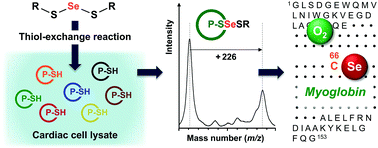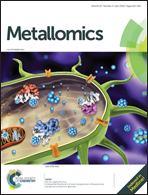Cardiac myoglobin participates in the metabolic pathway of selenium in rats†
Abstract
As an essential micronutrient, selenium deficiency is a leading cause of cardiovascular diseases. The heart is continuously beating to deliver blood to the entire body, and this requires a high amount of energy. An adult heart normally obtains 50–70% of its adenosine 5′-triphosphate from fatty acid β-oxidation. An increase in fatty acid oxidation activity induces the generation of larger amounts of by-products (reactive oxygen species, ROS) from mitochondrial oxidative phosphorylation. Selenium-dependent glutathione peroxidases play a critical role in the removal of these ROS, especially organic hydroperoxides, from the heart. The definitive transport and/or detailed metabolic pathways from the selenium-source compounds to the selenoproteins in the heart still remain unclear. We explored the selenium-binding proteins in a rat cardiac cell lysate using its reactive metabolic intermediate, selenotrisulfide (STS), and MALDI TOF-mass spectrometry. Several proteins with a free cysteine (Cys) thiol were found to be reactive with STS through a thiol-exchange reaction. The most distinctive Cys-containing protein in the cardiac cell lysate was identified as myoglobin (Mb) from a rat protein database search and tryptic fragmentation experiments. When separately examined in selenium adequate rats, selenium-binding to the cardiac Mb was verified using selenium-specific fluorometry. Cardiac Mb is thought to participate in the selenium metabolic pathway in the heart.

- This article is part of the themed collection: Metallomics in Japan


 Please wait while we load your content...
Please wait while we load your content...